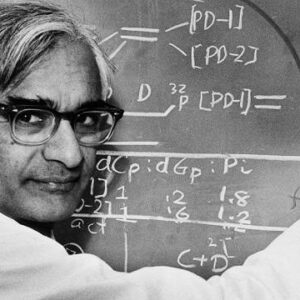Har Gobind Khorana was an American biochemist who was born in India. He was part of the team that cracked the genetic code, which is called the “mother of all codes.” From being a young boy who learned his first lessons from a village teacher under a tree to becoming a world-famous biochemist, his life was full of interesting things. Even though he was born to poor parents, they wanted him to have a good education. He was always a good student, so it wasn’t a surprise when he won a scholarship to study chemistry at the Punjab University. He did very well in school and soon went to the University of Liverpool on a scholarship from the Government of India to study at a higher level. He was interested in human genetics, so he started experimenting with RNA’s nucleic acids. In 1968, he shared the Nobel Prize for Medicine with Marshall W. Nirenberg and Robert W. Holley for his work in the field of DNA, which holds the genetic code of all living things. Now that he was an American citizen, he was always finding out new things about human genetics.
Early years and childhood
He was born in a village in West Punjab to Hindu parents. He was their youngest child. He had one sister and three older brothers. His father was the “patwari,” or tax collector, for the village.
Even though his family was poor, his father made sure he got a good education. He went to a local school when he was young, where a village teacher taught him under a tree. His father also taught him at home. His family was the only ones in the whole village that could read and write.
He went to D.A.V. High School in Multan, where his teacher Ratan Lal had a big impact on him. He got a scholarship to go to the Punjab University in Lahore to study chemistry.
In 1943, he got his B.Sc., and in 1945, he got his M.Sc. The Indian government gave him the scholarship to study at the University of Liverpool because he was such a good student.
He went to England and got his Ph.D. at the University of Liverpool, where Roger J.S. Beer was his advisor. It was the first time he had ever been outside of India, and he learned about Western culture through this trip. In 1948, he got his Ph.D.
He kept studying at the Eidgenossische Technische Hochschule in Zurich with Professor Vladimir Prelog after he got his Ph.D. His professor had a big impact on how he thought about science and how he felt about it.
Har Khorana’s Career
In 1952, Dr. Gordon M. Shrum of the University of British Columbia in Vancouver offered him a job. Even though the British Columbia Research Council didn’t have many places to do research, he agreed to work there.
Dr. Shrum was a very inspiring person, and Khorana could do any kind of research with him. He started working in the field of phosphate esters and nucleic acids with a group of other researchers.
In 1960, he took a job at the University of Wisconsin’s Institute for Enzyme Research.
In the 1960s, he did more research on nucleic acids found in RNA, which is a chemical that translates the genetic information found in DNA. The letters A, C, U, and G stand for the four chemical bases that make up RNA.
Khorana figured out that the code for serine was UCU and the code for leucine was CUC by putting the chemical bases together. He showed that there were 64 different three-letter words in the genetic code.
Marshall W. Nirenberg, a biochemist, had also been working on genetics, and Khorana confirmed that the spiral staircase of the DNA molecule is made up of four different kinds of nucleotides.
He showed that the nucleotide code is sent to the cells in groups of three. These groups are called codons. Some codons tell the cells to start making proteins or stop making them.
In 1970, he started working at the Massachusetts Institute of Technology (MIT) as the Alfred Sloan Professor of Biology and Chemistry. He stayed there until he retired in 2007.
In 1972, he was able to make the first gene that was made in a lab. A few years later, he got the fake gene to work in a cell of bacteria. Only because we know how to make DNA from scratch has genetic engineering become possible.
In his later years, he did research on the molecular processes that make up the cell signaling pathways that allow vertebrates to see. He mostly looked at the structure and function of rhodopsin, a protein in the eye that responds to light.
Works of note
Har Gobind Khorana was a biochemist who was known all over the world for his work in genetics and DNA. He was the first person to show that nucleotides play a role in making proteins.
Awards & Achievements
In 1968, Har Gobind Khorana, Robert W. Holley, and Marshall W. Nirenberg shared the Nobel Prize in Physiology or Medicine “for their interpretation of the genetic code and how it works in protein synthesis.”
Personal History and Legacies
In 1952, he married a Swiss woman named Esther Elizabeth Sibler. There were three kids in the family. One of their daughters died in 1979, which was sad. They were happy together until Esther died.
He lived a long time and died in 2011 at the age of 89 from natural causes.
Estimated Net worth
Har Gobind Khorana’s estimated net worth is $3 million, and his main sources of income are as a professor, chemist, biologist, geneticist, and geneticist. We don’t know enough about Har Gobind Khorana’s cars or about his way of life.


